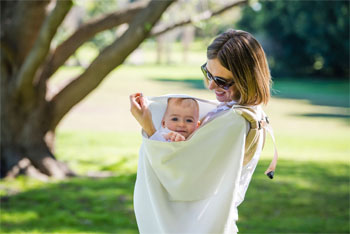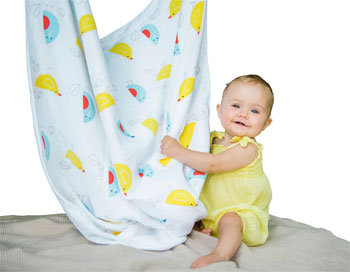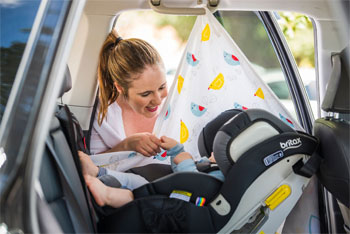Natasha Jacquot Musluv Interview

UPF 50+ Rated Muslin Cotton Covers to protect babies' skin this Summer.
The summer of 2017 was dubbed the 'angry summer' by climate scientists. Heat broke 205 records and more extreme weather is anticipated for 2018, Climate Council of Australia reports. Dr. Alice Rudd from Skindepth Dermatology says -it is important for all parents to be educated about sun damage- 100% of children will have moles on the skin by the age of two, compared to Spain where only 26% of children will have moles by age 10. Our Australian sun is one of the most brutal and harmful contributors to sun damage; it is possible that early sun exposure kicks off a mutagenic pathway that is exacerbated with every subsequent sun exposure. Mothers need to be educated about their baby's skin/ and shield it from the harsh rays.'
The mechanism by which a baby's skin is more sensitive are not entirely known. There have been studies showing that skin becomes thicker with age, and that the thinner skin of babies may confer less potent protection against damaging UV rays, meaning it can burn more easily. Whilst it's difficult to say how much of adult sun damage occurs because of childhood exposure, it has been reported that exposure to high levels of sunlight in childhood is a strong determinant of melanoma risk
Musluv muslin baby covers help protect babies' skin with a layered technology that provides superior UV protection and retains breathability and tested air permeability for baby's safety and comfort. The design also features cotton ties on each corner of the wrap that can easily attach to a baby carrier or pram, allowing for increased ventilation and for heat to escape.
Dr Ritu Gupta, specialist dermatologist from Platinum Dermatology Skin Specialists in Ultimo, says -I think that there is a lack of awareness amongst parents of the extent of the need for sun protection in babies. If you hold a muslin up and see the light through it, then it's probably only going to have a UPF of about 8. Covering a pram with ordinary muslin is inadequate. It's really a matter of education – parents know that they should use a pram cover but they need to make sure it really is effective at blocking UV, otherwise it's just giving a false sense of security.'
Musluv muslin baby covers are incredibly versatile and can be used as a baby wrap, light blanket, pram cover, mat, car window sun shield or burp cloth; making them the perfect gift for expectant mothers.
Founder of musluv, Natasha Jacquot says, 'The reason why we developed musluv covers is because we were worried by the numbers of mums and dads we saw covering their prams with muslin wraps and blankets, unaware of how little sun protection they give. We wanted to give them a flexible solution for all outdoor situations."
Musluv muslin baby covers set the benchmark for luxe design, set to stand the test of time. Consumers can purchase with confidence knowing that musluv muslin covers are machine washable and have been subject to a rigorous testing regime before being released to the market.
Musluv's UV treatment follows the Oeko-Tex 100 standard of safety ensuring that it contains absolutely no harmful substances.
 Interview with Natasha Jacquot
Interview with Natasha Jacquot
Question: What originally inspired the creation of Musluv?
Natasha Jacquot: I was inspired to create musluv through my own need as a new parent for a good, flexible sun shade solution.
Once, I was on the top open-level of a shopping centre car park with my first baby, Alex. There was no shade, the sun was beating down and the entrance to the mall felt like it was miles away. I felt completely stuck and I didn't know how to transfer him from the car to the mall safely. I ended up having to half-jog with him in my arms across the car park, praying I wouldn't trip, to try and avoid exposing him to UV unnecessarily.
I didn't want other parents to be in that same position I was. I knew that what parents really needed was a solution that was very simple and always on hand.
Question: Can you talk us through the development of the product?
Natasha Jacquot: It took years!
We knew that we wanted to make a product that was made of natural fibres, was very breathable and safe, and had superb sun protection.
We read a lot of technical textile journals and then we tested out some theories, whilst doing test after test through the ARPANSA and other laboratories.
We were rigorous in our testing. We made sure that the product achieved and retained its UPF 50+ rating, even through extensive wash-testing. We also ensured that air could flow freely through the fabric, and we added ties so that the cover could be attached with open ventilation gaps to combat overheating. And of course, we also made sure the fabric was non-toxic.
As a mum, I knew that these would be the concerns of any parent and I wanted them to be confident of a safe, trustworthy product for their babies.
Once we achieved this, we then took out a patent on the product.
Question: What causes damaging effects to a baby's skin?
Natasha Jacquot: Researchers think that there are certain times in a person's life when the effects of sun exposure are stronger and cause more damage to skin cells than at other times. Early childhood is one of those times.
It could be because baby skin is much thinner than adult skin. Or it could be that damage, which triggers cell reactions leading to skin cancer later on, happens more quickly to a baby's immature cells.
Question: How will this affect their skin, in the future?
Natasha Jacquot: No-one knows definitively what the effects will be, but there is strong evidence that childhood sun exposure somehow contributes significantly to the overall lifetime risk of skin cancer later on in life.
Question: Can moles be dangerous?
Natasha Jacquot: Moles are generally harmless in themselves, according to SunSmart. But, whilst some moles appear soon after birth, others are acquired through sun exposure. So many moles can be a sign that a child has had a lot of exposure to the sun, and this in turn can increase the chance of melanoma later in life.
Question: How can we reduce these damages?
Natasha Jacquot: Parents can reduce the likelihood and extent of any sun damage by making sun protection for our babies a part of their everyday routine. The knowledge about sun care is actually quite high in Australia, but that doesn't necessarily translate into good, consistent sun care practice every single day.
Perhaps we forget about sun protection when we're in the car, or we don't worry too much if the weather is cloudy. But we should.
Everyone's skin is like a memory bank which 'remembers" each exposure to UV and the effects of sun damage add up over time, so it's something we need to think about almost every single day in Australia.
 Question: Do babies need to wear hats or have their bodies covered all year round?
Question: Do babies need to wear hats or have their bodies covered all year round? Natasha Jacquot: Whilst the guidelines of some other countries say that young babies should be kept out of direct sun completely, our Australian guidelines are slightly different and say parents need to think about sun protection if the UV level is 3 or above (or if they are spending an extended amount of time outdoors with their babies during lower UV times).
The problem is that the majority of Australia is at an average UV level of 3 or above even during winter. And unfortunately there are no specific guidelines on exactly how much unprotected sun exposure is safe for babies, although we are talking about a matter of a few minutes.
So we would say, babies should be covered up the large majority of their time outside, throughout the year. If parents are planning a trip outside they should make sure they are taking long-sleeved pants and t shirts and other sun protection for their baby with them.
Interview by Brooke Hunter
MORE



